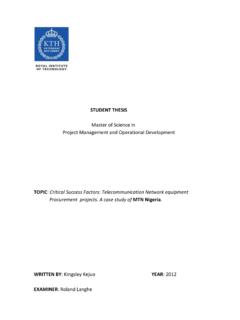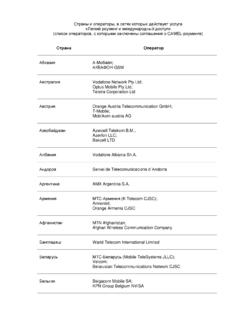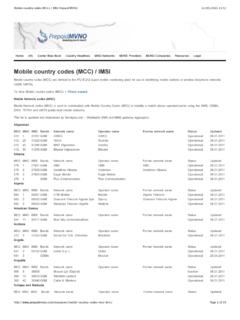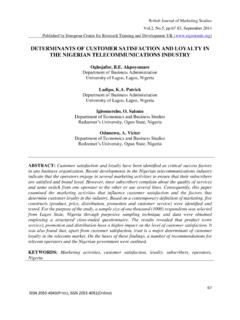Transcription of FSAN Highlights & NG-PON2 Standards Update
1 fsan Highlights & NG-PON2 Standards Update fsan and IEEE NG-EPON/1904 ANWG Joint Session hosted by CableLabs February 4, 2015 Martin Carroll Derek Nesset, Peter Dawes fsan Chair fsan NGPON TG Co-chairs NTT KT Bell Canada AT&T Verizon CenturyLink Orange BT DT TI Telus Kuwait MOC SaskTel Chunghwa China Telecom ETISALAT CTBC China Mobile Telstra Telefonica du SK China Unicom Telekom Malaysia PT Vodafone Guided by global operator community 2 KDDI Cox Comcast fsan (Full Service Access Network) is an industry interest group Global operator adoption leads to higher volumes and lower costs for all Facilitate Standards development for new, fibre-based access systems Resultant Standards enable future-proof broadband access networks Activities support ITU-T standardization Develop operator Standards requirements Identify, assess, evaluate technical solutions Publish findings/recommendations in White Papers, press releases.
2 And technical articles Individual fsan member companies contribute results into the ITU-T Study Group 15 Industry ecosystem well represented 3 as of Nov 2014 fsan structure 4 Next Generation PON Task Group Full Services Access Network Management Committee fsan Optical Access Network Working Group Operations & Engineering Task Group Optical Line Monitoring Study Group OISG Energy Efficiency Study Group Interoperability Study Group Mobile Fronthaul Study Group Standards development and interop APON/BPON Gb/s DS, 622 Mb/s US Series GPON Gb/s DS, Gb/s US Series XG-PON1 10 Gb/s DS, Gb/s US Series, NG-PON2 40 Gb/s DS, 10 Gb/s US Series Late 1990s 2003/2004 2009/2010 2014/2015 Requirements Standards Interop Testing Factors driving new Standards Need to improve cost/performance Consolidate service platforms to drive down TCO and/or WLC Increasing competition on Speed Address new application spaces fsan Roadmap 6 NG-PON2 Project in fsan fsan initiated the NG-PON2 project in 2010 Started with initial workshops concerning the technology options fsan Operators then developed a White Paper concerning their requirements for NG-PON2 Followed by a Technology White Paper that proposed various NG-PON2 systems capable of meeting these requirements Through a process of requirements refinement to identify the must haves.
3 System technologies were systematically set aside Continual checking throughout that we had sufficient understanding of both the technologies and requirements 7 Drivers for NG-PON2 Future optical access networks are expected to be truly multi-service High Level Target Requirements for NG-PON2 Increased aggregate capacity per OLT PON port ( 40 Gbit/s) Downstream 1 Gbit/s and upstream to 1 Gbit/s sustainable bandwidth on any ONU Support 64 ONUs per port (256 ONUs or more also of interest) Compatible with legacy PON infrastructure (> 40 km reach) 40 km differential reach Smooth Migration Legacy PON co-existence (G-PON and/or XG-PON1) Smooth migration from a legacy PON on a per ONU basis Support for multiple applications on the same ODN ( residential + business + backhaul) Embedded Test & Diagnostic capabilities Capable of reaching 60 km (preferably passive) Support of PON resilience, including dual parenting 9 Selected NG-PON2 Technologies TWDM-PON selected as the primary technology solution for NG-PON2 (in April 2012) With PtP WDM overlay channels Many proposals concluded that the mobile fronthaul application was very challenging with TDMA-PON and easier to handle using dedicated wavelength channels Decision based on considerations of system cost, technology maturity, loss budget, complexity and power consumption.
4 TWDM-PON does not excel in any one performance metric but provides a good balance of attributes for mass market residential broadband applications. It offers good performance with reasonable cost, using components mature enough to meet the NG-PON2 timescales. With the technology studies and consensus as a basis, NG-PON2 began ITU-T standardisation in 2012 First recommendation ( ) defined the system Requirements; drawing extensively from the fsan Operator White Paper Consented in September 2012 10 what is NG-PON2 ? 11 NG-PON2 = 40 Gigabit Capable Multi-Wavelength PON System Ch. # Base = 1 4 TWDM (TDM/WDM) and Option = up to 8 PtP WDM (Ch# 8) TWDM Ch. Rates Base = 10 and Options =10/10G and PtP WDM Ch. Rates 1G, and 10G classes ONUs are colourless and can tune to any assigned Channel CT = Channel Termination WM = Wavelength Multiplexer Flexible deployment options 12 Wireless access pointFTTHFTTHFTTHFTTHPtP WDM OLT TWDM OLT Wireless access pointPtP WDM OLT Wireless access point100% WDM option for business parks, wireless services etc Greenfield Option for mainly FTTH areas and for legacy infrastructure More wavelengths More TDMA Power Split Wave Split Co-existence 13 G-PON NG-PON2 CT-1 WM NG-PON2 CT-2 NG-PON2 CT-3 NG-PON2 CT-4 XG-PON1 CEx XG-PON1 ONU NG-PON2 ONU 1 NG-PON2 ONU 2 NG-PON2 ONU 3 NG-PON2 ONU 4 G-PON ONU CEx = Co-existence Element ( WDM) WM = Wavelength Multiplexer Co-existence with RF Video Overlay at 1555nm is accommodated by the wavelength plan but may need methods to compensate for Raman crosstalk that can impact lower frequency RF channels.
5 Due to the variety of RF Video implementations this will require joint engineering between the system vendor and network operator Legacy PON TWDM PON and/or PtP WDM PON NG-PON2 Wavelength Plan 14 Full co-existence with legacy ITU-T PONs (G-PON, XG-PON1) and RF video Enables a single Standard to meet the requirements of all fsan Operators Facilitates worldwide standard and volumes to lower costs Downstream The TWDM channels fit between XG-PON1 (DS) and OTDR (monitoring band). This enables simultaneous co-existence with legacy PON (G-PON and XG-PON1) and 1550nm RF video Upstream The TWDM channels work in the C-band above the WDM1r co-existence filter edge and below the 1550nm RF video band. Use of C-band enables lower costs at the ONUs The PtP WDM Channel Band is configured as a mixed US and DS plan according to Operator requirements Wavelength plans TWDM DS : 1596-1603 nm US : 1524-1544 nm (Wide) 1528-1540 nm (Reduced) 1532-1540 nm (Narrow) Upstream wavelength options driven by differing capabilities of the ONU Tx to control it s wavelength Wide band option is useable by a Wavelength Set approach to channel control where a DFB laser may drift over a wide range Narrow band option may be most appropriate for temperature controlled lasers that can lock onto an assigned DWDM wavelength PtP WDM US/DS : 1603-1625 nm (Shared Spectrum) US/DS.
6 1524-1625 nm (Expanded Spectrum) Shared spectrum is the useable wavelength band considering the scenario of full co-existence with legacy PON systems Expanded Spectrum fully exploits the concepts of spectral flexibility in NG-PON2 by enabling bands not being used to be utilised by PtP WDM. This option may also be most beneficial in a Greenfield scenario with no legacy co-existence limitations 15 Line Rates 16 TWDM Downstream line rate (Gbit/s) Upstream line rate (Gbit/s) Basic Rate Rate Option 1 Rate Option 2 PtP WDM Downstream/Upstream line rate (Gbit/s) Class 1 - Class 2 - Class 3 Class 4 (still under study) Clients: Ethernet, CPRI, SDH/SONET, OTN Compatibility with legacy ODN 17 It is a fundamental requirement of NG-PON2 that it works over power splitter based PONs Furthermore, NG-PON2 is compatible with legacy loss budget classes B+ / C+ (G-PON) and N1 / N2 / E1 / E2 (XG-PON1).
7 And legacy differential losses (15dB) & differential reach (40km) NGPON2 CT-n .. Power Splitter NGPON2 CT-1 WM NGPON2 CT-2 NGPON2 CT-3 NGPON2 ONU NGPON2 ONU NGPON2 ONU NGPON2 ONU CEx N1, N2, E1, E2 B+/C+ ODNs optional Optical Path Loss and Fibre Distance Classes 18 Class N1 Class N2 Class E1 Class E2 Min Loss (dB) 14 16 18 20 Max Loss (dB) 29 31 33 35 Maximum differential optical path loss = 15 dB Fibre distance class Minimum (km) Maximum (km) DD20 0 20 DD40 0 40 Incremental Upgrade (Pay-as-you-Grow) 19 DS capacity = 10Gb/s US capacity = DS capacity = 20Gb/s US capacity = 5Gb/s DS capacity = 30Gb/s US capacity = .. Splitter NGPON2 CT-1 WM NGPON2 CT-2 NGPON2 CT-3 NGPON2 ONU NGPON2 ONU NGPON2 ONU NGPON2 ONU NGPON2 ONU NGPON2 ONU NGPON2 ONU Incremental capacity can be added by provisioning additional NG-PON2 OLT channels. The ONUs are colourless and can tune to any NG-PON2 channel.
8 This can also allow channel capacity management by redistributing ONUs across the available NG-PON2 channels Classes of Tx/Rx Wavelength Channel Tuning Time 20 Classes for the wavelength channel tuning time of the ONU Tx and Rx are defined These Classes open up various use cases for wavelength tunability dynamic wavelength assignment and advanced power saving The classes were broadly defined based on known wavelength tunable technologies Class 1 components may include switched laser or filter arrays Class 2 components may be based on electronically tuned lasers (DBR) Class 3 components could be thermally tuned DFBs Class 1 < 10 s Class 2 10 s to 25 ms Class 3 25 ms to 1 s Use cases enabled by wavelength agility TWDM PON allows enhanced network functionalities unavailable in previous generations of pure TDM PONs. Incremental bandwidth upgrade (pay-as-you-grow) Load balancing under for congested wavelength channels Selective OLT port sleep for power saving during low traffic periods Resilience against OLT transceiver failures through ONU retuning Fast, dynamic wavelength and timeslot assignment using DWBA (extra degree of freedom DBA today) to improve bandwidth utilisation efficiency Application details depend on Tx/Rx Tuning Time Class 21 OLT Power Saving 22 ONU 3 ONU 4 ONU 2 ONU 4 ONU 3 ONU 2 ONU 1 OLT CT-4 OLT CT-1 OLT CT-2 OLT CT-3 During times of low traffic load ( overnight)
9 All ONUs can retune to a common wavelength and allow OLT ports to be powered down Protection and Resilience for Service Restoration 23 OLT 4b OLT CT-4b ONU 1 ONU 4 ONU 4 ONU 2 ONU 2 ONU 3 ONU 3 OLT CT-4a OLT CT-1a OLT CT-2a OLT CT-3a OLT CT-1b OLT CT-2b OLT CT-3b ONU 1 Primary OLT Secondary OLT Fibre cut All ONUs can retune to a common standby wavelength under a fault condition to maintain a basic service until the fault is cleared Standards progress Standardisation of NG-PON2 is proceeding rapidly in the ITU-T (considering the extra complexities involved) contains the general requirements for the NG-PON2 (approved and published) specifies parameters for the physical layer (approved Dec. 2014) Wavelength plans Optical loss budgets Line rates Modulation format Wavelength channel parameters (spectral excursion, Tx SNR, etc) ONU tuning time classes specifies transmission convergence (TC) layer protocols for NG-PON2 (consent targeted Jul.)
10 2015) (no dot) contains the common definitions, acronyms, abbreviations, and conventions of the series of Recommendations (consent targeted Jul. 2015) fsan and ITU-T (Q2/15) are working together to complete the series + any necessary OMCI changes to 24 NG-PON2 transmission convergence layer NG-PON2 has new capabilities that need protocol support Multiple wavelengths TWDM and point-to-point channels Start with a single channel, add more later Distributed OLT CTs can drive a single fibre 25 ONU 2 ONU 2 ONU 1 OLT CT-4 OLT CT-1 OLT CT-2 OLT CT-3 Inform ONUs of PON system id, downstream channel id ONUs must transmit in correct channel New protocol functions Multiple wavelengths so protocol supports tuning New identities needed to distinguish system, wavelength channel PtP WDM and TWDM activation and management need new protocol Dealing with ONUs with uncalibrated lasers that must not be allowed to transmit in the wrong wavelength channel Distributed OLT channel terminations need inter-channel messaging for some procedures New rogue scenarios to be detected and mitigated 26 Tuning support and identities Tuning supported by Revised ONU state machine covering activation and channel management PLOAM messages added to control tuning New ONU parameter for tuning time Identities for multiple wavelengths and distributed OLT CTs Each downstream channel wavelength advertises channel information including channel number and an identity of the PON system that owns the channel OLT CT can feed back upstream channel identity to ONU ONU can feed back the downstream channel and system identity it is receiving to OLT CT Distributed







